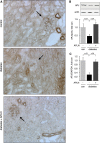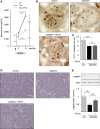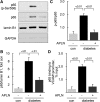Apelin retards the progression of diabetic nephropathy
- PMID: 23303408
- PMCID: PMC3602700
- DOI: 10.1152/ajprenal.00306.2012
Apelin retards the progression of diabetic nephropathy
Abstract
Apelin and its receptor APJ have pleiotropic effects in mice and humans and play a protective role in cardiovascular diseases at least partially by inhibiting oxidative stress. Our objective was to study the effect of apelin on the progression of kidney disease in mice with established type 1 diabetes. Ove26 mice with type 1 diabetes received daily subcutaneous injections of apelin for 2 or 14 wk. APJ localizes in the glomeruli and blood vessels of kidneys. Renal APJ expression was reduced in diabetic mice but increased after treatment with apelin. Apelin treatment did not affect glycemia, body weight, or blood pressure in diabetic mice. Whole kidney and glomerular hypertrophy, as well as renal inflammation, including monocyte chemoattractant protein 1 and vascular cell adhesion molecule 1 expression, NF-κB activation, and monocyte infiltration, was inhibited after short and long treatment with apelin. Apelin administration significantly reduced albuminuria at 6 mo. Short treatment with apelin was sufficient to reverse the downregulation of the antioxidant enzyme catalase. Expression of angiotensin II and angiotensin type 1 receptor (AT1) in kidneys from diabetic mice treated was not affected by apelin. These findings show for the first time that apelin exerts a protective effect on the diabetic kidney. Short administration is sufficient to reduce kidney and glomerular hypertrophy as well as renal inflammation, but prolonged treatment is required to improve albuminuria. This effect was independent of the activation of the renin angiotensin system but correlated with upregulation of the antioxidant catalase. Apelin may represent a novel tool to treat diabetic nephropathy.
Figures










References
-
- American Diabetes Association Position statement: diabetic nephropathy. Diabetes Care 24: S69– S72, 2001 - PubMed
-
- Andersen S, Tarnow L, Rossing P, Hansen BV, Parving HH. Renoprotective effects of angiotensin II receptor blockade in type 1 diabetic patients with diabetic nephropathy. Kidney Int 57: 601– 606, 2000 - PubMed
-
- Ashley E, Chun HJ, Quertermous T. Opposing cardiovascular roles for the angiotensin and apelin signaling pathways. J Mol Cell Cardiol 41: 778– 781, 2006 - PubMed
-
- Baynes JW. Role of oxidative stress in development of complications in diabetes. Diabetes 40: 405– 412, 1991 - PubMed
-
- Chen MM, Ashley EA, Deng DX, Tsalenko A, Deng A, Tabibiazar R, Ben-Dor A, Fenster B, Yang E, King JY, Fowler M, Robbins R, Johnson FL, Bruhn L, McDonagh T, Dargie H, Yakhini Z, Tsao PS, Quertermous T. Novel role for the potent endogenous inotrope apelin in human cardiac dysfunction. Circulation 108: 1432– 1439, 2003 - PubMed
Publication types
MeSH terms
Substances
Grants and funding
LinkOut - more resources
Full Text Sources
Other Literature Sources
Medical
Molecular Biology Databases
Research Materials

